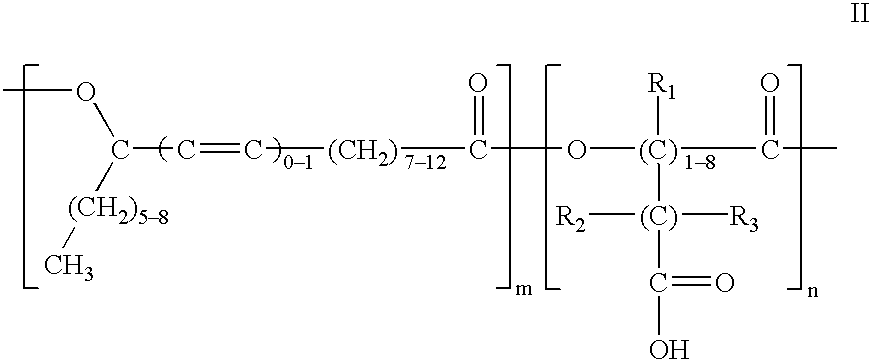Polyesters based on hydroxy fatty acids and lower hydroxy alkyl acids and uses thereof
a technology of hydroxy fatty acids and polyethylene glycol, which is applied in the field of polyethylene glycol, can solve the problems of limited value in routine cosmetics, accelerated skin ageing, and uv-b has the greatest potential for skin damage, and achieves the effects of reducing the risk of skin damag
- Summary
- Abstract
- Description
- Claims
- Application Information
AI Technical Summary
Benefits of technology
Problems solved by technology
Method used
Image
Examples
example 2
Synthesis of Poly[(Lactic Acid)-Co-(Ricinoleic Acid)] by Transesterification
[0098] Into a one-liter four neck flask equipped with stirrer, thermometer, nitrogen gas inlet tube and water separator, were charged 103.6 grams of lactic acid (88%), 315 grams of methyl ricinoleate and 0.8 grams of potassium carbonate. The resulting reaction mixture was heated at 155.degree.-160.degree. C. for four hours with stirring while nitrogen gas was being blown therethrough. After completion of the reaction, the reaction product was washed with water, vacuum-dried, and deodorized with steam at reduced pressure to yield polyesters having the following properties: Acid Value (AV) 9.2; Hydroxy Value (HV) 70.7 and ester value of 281.
example 3
Synthesis of Poly[(Lactic Acid)-Co-(Ricinoleic Acid)]
[0099] Into a two-liter four neck flask equipped with stirrer, thermometer, nitrogen gas inlet tube and water separator, were charged 302 grams of lactic acid, 800 grams of ricinoleic acid and 6.6 grams of sodium hypophosphite. The resulting reaction mixture was heated at 155.degree.-160.degree. C. for three hours and then at 190.degree.-200.degree. C. for about 68 hours with stirring while nitrogen gas was being blown therethrough. After completion of the reaction, the reaction product was washed with water, vacuum-dried, and deodorized with steam at reduced pressure to yield polyesters having the following properties: Acid Value (AV) 27.57; Hydroxy Value (HV) 12.46; and a saponification value of 319.47.
example 4
Synthesis of Poly[(Glycolic Acid)-Co-(Ricinoleic Acid)]
[0100] Into a one-liter four neck flask equipped with stirrer, thermometer, nitrogen gas inlet tube and water separator, were charged 76 grams of glycolic acid (90% purity) and 308 grams of ricinoleic acid. The resulting reaction mixture is heated at 150.degree.-155.degree. C. for six hours with stirring while nitrogen gas was being blown therethrough. After completion of the reaction, the reaction product was washed with water, vacuum-dried, and deodorized with steam at reduced pressure.
PUM
| Property | Measurement | Unit |
|---|---|---|
| Fraction | aaaaa | aaaaa |
| Percent by mass | aaaaa | aaaaa |
| Percent by mass | aaaaa | aaaaa |
Abstract
Description
Claims
Application Information
 Login to View More
Login to View More - R&D
- Intellectual Property
- Life Sciences
- Materials
- Tech Scout
- Unparalleled Data Quality
- Higher Quality Content
- 60% Fewer Hallucinations
Browse by: Latest US Patents, China's latest patents, Technical Efficacy Thesaurus, Application Domain, Technology Topic, Popular Technical Reports.
© 2025 PatSnap. All rights reserved.Legal|Privacy policy|Modern Slavery Act Transparency Statement|Sitemap|About US| Contact US: help@patsnap.com



